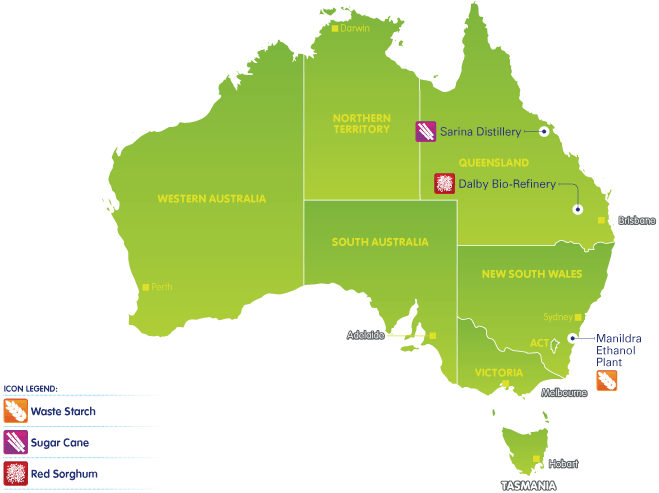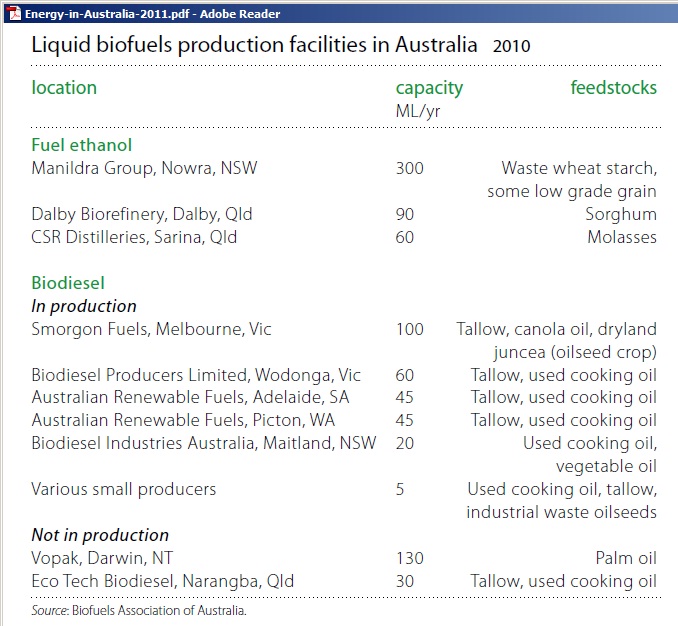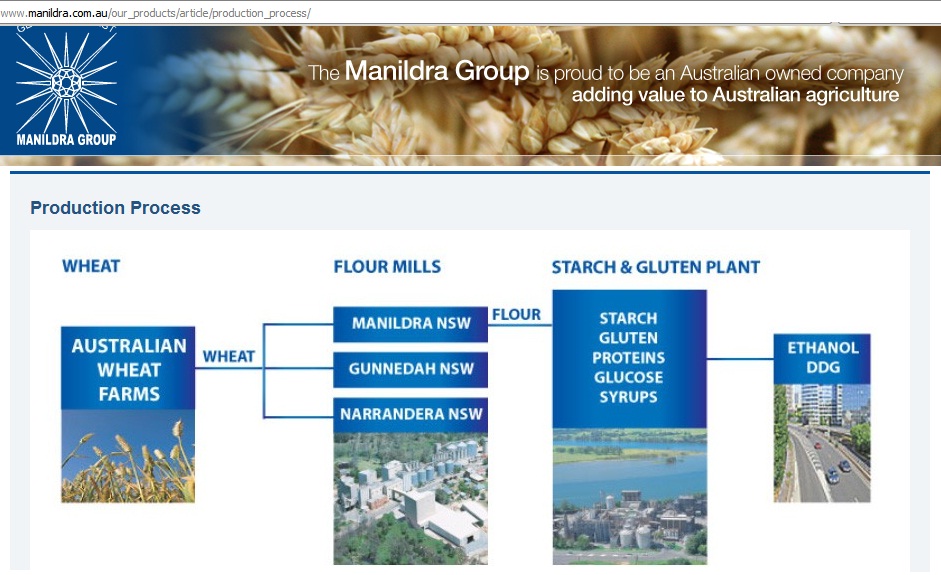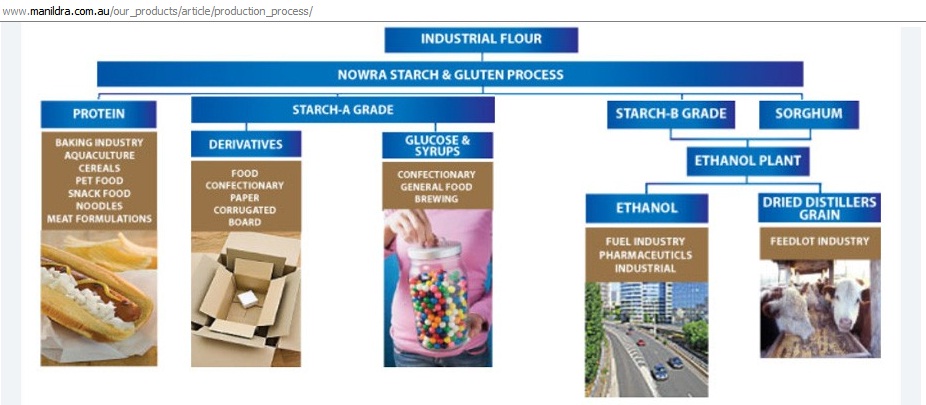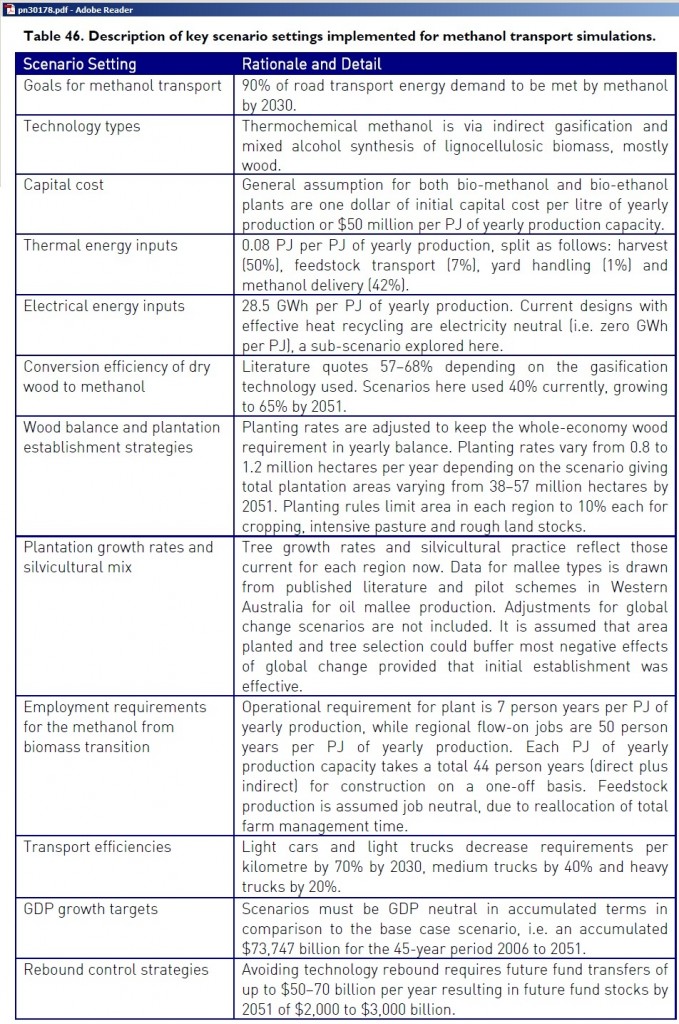On past trends of growing ethanol use in cars it would take 14 years to replace all unleaded petrol presently used in Australia. Any traffic growth, e.g. caused by the current ambitious immigration program, would prolong this period. Such an E10 strategy would require that every 3 years an additional ethanol plant with a capacity of 240 ML be built including associated infrastructure and a reliable source of biomass, independent of extreme weather events like drought and floods, not to mention climate change. The end result of such a strategy would be that just 10% of ULP is “saved” and CO2 emissions reduced by 3-4%.
Such a reduction in both petroleum use and emissions is nowhere near enough to achieve recent APEC energy intensity targets nor to replace declining oil production as shown in the leaked BITRE report 117, let alone a 30% decline of available net crude oil exports by 2020 as calculated by Jeff Brown at the ASPO 2011 conference. Nor would it be in line with Australia’s overall objective to reduce emissions by between 5-15% by 2020.
It is recommended that ethanol not be wasted on the urban motorist but rather used in farming areas as E85. When developing bio fuels, the focus should be on bio-diesel to run farming machinery and trucks so that food production is less dependent on oil.
—————
The year in New South Wales started with this announcement :
Unleaded ban expected to cause rise in fuel prices
1/1/2012
NSW drivers could face more petrol price rises this year after the government bans regular unleaded fuel, pushing up demand for ethanol-blended and premium unleaded fuel, the industry has warned.
To meet demand, the state’s only ethanol distiller, Manildra Group, will need to increase its production of ethanol-blended petrol to 300 megalitres by July, up from 250 megalitres last financial year, according to Ecco Consulting, an energy advisory firm.
‘Ethanol has proved very unpopular with customers,” said Paul Zennaro, of Shell, which says it supports ethanol fuel but not through a mandated quota.
and 2 weeks later:
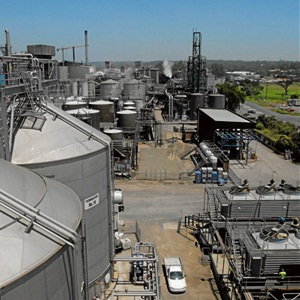 Green fuel fails to meet emissions standards
Green fuel fails to meet emissions standards
17/1/2012
The NSW government’s plan to ban regular unleaded fuel has been thrown into doubt by the revelation that the state’s only ethanol producer, Manildra, has failed the government’s clean fuel test, with its ethanol producing more greenhouse gas emissions than previously thought.
Update 31/1/2012
Premier bows to motorists on unleaded fuel
THE state government has caved in to criticism of its decision to ban regular unleaded petrol from July 1, a week after a cabinet leak revealed it had planned to proceed with the ban despite advice it would drive up petrol prices.
Last Monday the Herald revealed that up to 750,000 motorists would pay more than $150 a year extra as they would be forced to use premium fuel because their cars were incompatible with E10.
This demonstrates that fuel mandates which replace petroleum based products and cost more have no chance of being implemented. Lets’ have a look at the numbers.
http://www.biofuelsassociation.com.au/images/stories/ethanol-map_new.gif
http://www.ret.gov.au/energy/Documents/facts-stats-pubs/Energy-in-Australia-2011.pdf
Statistics confirm what Shell says. At a national level, use of E10 has peaked in December 2010 at 300 ML per month equivalent to 30 ML ethanol per month:
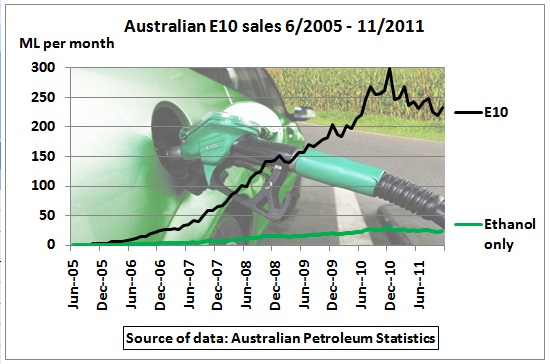 Data from:http://www.ret.gov.au/resources/fuels/aps/pages/default.aspx
Data from:http://www.ret.gov.au/resources/fuels/aps/pages/default.aspx
Now let’s see how that fits into the overall picture of fuel supplies for passenger cars
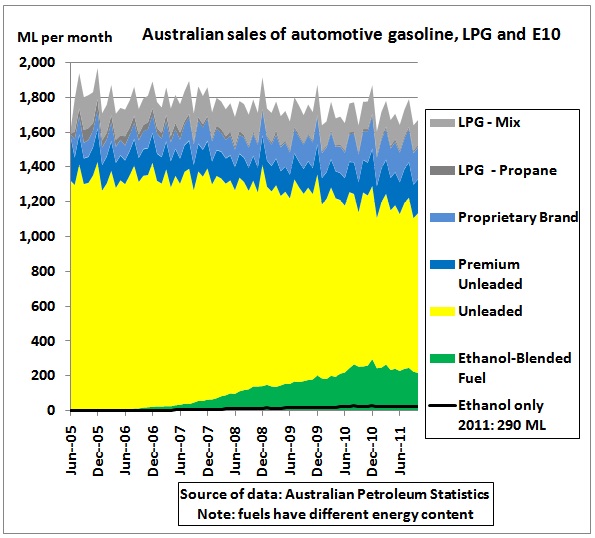 In the last 12 months 2,950 ML of E10 (295 ML of ethanol) were used compared to 11,244 ML of unleaded petrol, that is 20.8% of 14,194 ML of ULP and ethanol blend. But the quantity of ethanol as a percentage of this part of the petrol consumption is only one tenth, that is 2.1%. As can be seen from the graph the growth rate was quite high until the peak. End 2010 an additional 800 ML E10 were used compared to end 2009.
In the last 12 months 2,950 ML of E10 (295 ML of ethanol) were used compared to 11,244 ML of unleaded petrol, that is 20.8% of 14,194 ML of ULP and ethanol blend. But the quantity of ethanol as a percentage of this part of the petrol consumption is only one tenth, that is 2.1%. As can be seen from the graph the growth rate was quite high until the peak. End 2010 an additional 800 ML E10 were used compared to end 2009.
Let us assume for a moment that this growth of 800 ML E10 would resume and continue linearly, then it would take 11,244/800 = 14 years until all ULP is replaced by E10, provided total consumption would not grow. The total saving in ULP would then be just 10% of current ULP consumption, achieved over a period of 20 years starting in 2005, the beginning of peak oil.
Even this slow growth would require that every 3 years an additional ethanol plant with a capacity of 240 ML pa be built including its associated infrastructure and reliable bio mass supply, in the case of Manildra, industrial wheat.
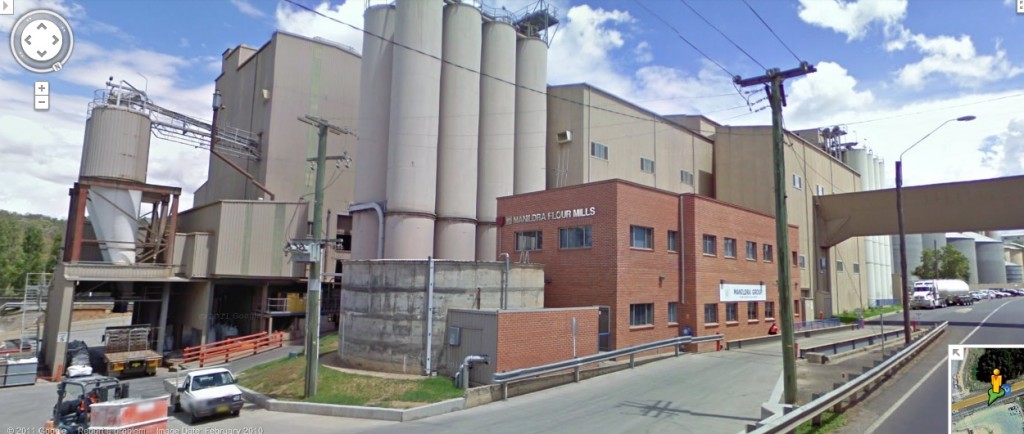 Street view of flour mill in Manildra, part of the wheat infrastructure
Street view of flour mill in Manildra, part of the wheat infrastructure
This site [Nowra] converts industrial grade wheat flour into its primary products of protein and carbohydrate. A by-product of the carbohydrate production is Ethanol.
Ethanol is commonly used in manufacturing for industries such as the Beverage, Food, Pharmaceutical, Personal Care, Ink, Industrial, Cleaning and Hygiene, Surface Coating and Explosives.
http://www.manildra.com.au/our_products/article/ethanol/
So if ethanol production were to be increased then all other products would have to be increased as well and markets found for them.
Can’t believe it takes 14 years? It takes only 5 minutes DIY for the financial year 2010/11
(1) Click on government web site
http://www.ret.gov.au/resources/fuels/aps/pages/default.aspx
(2) Click on the latest XLS file in the list of monthly files, the numbers are done for November 2011
(3) Tick “open with” and click “OK”, disable macros
(4) Click on table 3A and you get this view:
(5) In cell O9 you get ethanol for 2010/11 of 3,069 ML, in cell K9 unleaded 11,385 ML. Calculate 3,069/(3069+11,385) = 21.2% or ethanol 2.1 %
(6) Calculate annual growth from 2010 to 201: 3,069 – 2,288 = 781 (rounded 800 ML)
(7) Divide 11,385/800 = 14 years to replace 10% of ULP by ethanol
This slow speed of replacement is absolutely insufficient to compensate for the decline shown in the BITRE 117 report, not to mention available crude oil net exports, estimated at 30% by 2020.
New South Wales
NSW consumed 2,225 ML of E10 (out of a national of 2,950 ML) in the last 12 months, at a fairly constant level over the period. The national decline since Dec 2010 was mostly caused by decreasing sales in Queensland and Victoria.
 Around 36% of all petrol sold in NSW is E10, that is 3.6% ethanol.
Around 36% of all petrol sold in NSW is E10, that is 3.6% ethanol.
Unleaded has a share of 31%. If regular unleaded were to be replaced by E10, this would mean almost a doubling of E10 supplies by July 2012 or an increase of 222 ML pa ethanol to 415 ML pa. Manildra’s capacity is 300 ML. Therefore, ethanol would have to come from other States or from imports. We had this article, but the numbers are a bit different:
Ethanol producers ‘doomed by imports’
November 19, 2010
Ms Brodie said of the three Australian ethanol producers, Manildra is producing about 250 million litres a year, CSR’s Sarina distillery in Queensland produces 60 million, and the Dalby Bio-refinery, already in receivership, has capacity of about 80 million litres. BusinessDay understands that 350 million litres would be required for all NSW service stations to meet the 6 per cent mandate.
http://www.smh.com.au/business/ethanol-producers-doomed-by-imports-20101118-17z9t.html#ixzz1ilUe8pQr
Peak oil and emissions abatement
Let us check how objectives to reduce emissions correlate with decline rates of global oil exports
The Productivity Commission’s June 2011 report on carbon emission policies contains Appendix N “Supply side analysis for road transport” (bio fuels policies)
http://www.pc.gov.au/__data/assets/pdf_file/0005/109931/23-carbon-prices-appendixn.pdf
From the figures in the above table we can calculate:
|
CO2 emissions per litre |
Reduction | |||
| from ethanol | from petrol |
total blend |
||
| E10 |
0.1 * 1,942 |
0.9 * 3,023 |
2,915 |
-3.6% |
| E30 |
0.3 * 1,942 |
0.7 * 3,023 |
2,699 |
-10.7% |
| E85 |
0.85 * 1,942 |
0.15 * 3,023 |
2,104 |
-30.4% |
E30 would – in theory – be needed by 2020 to compensate for oil export decline (petrol cars using ULP only). This means the 2010/11 growth rate in the use of ethanol would have to be speeded up by a factor of 3 * 14 years / 9 years = 4.7 from Jan 2012. E30 by 2020 would require a capacity of 11,385 * 0.3 = 3,415 ML of ethanol or the equivalent of 10 additional Nowra type plants.
We can also see that E10 would reduce CO2 emissions by only 3-4% while the Federal government’s target is in the range of 5-15% by 2020.
In principle, replacing oil with bio fuels may reduce emissions of cars using such fuels, but not necessarily the ultimate CO2 concentration in the atmosphere. This is because any petroleum based fuel “saved” will be burnt somewhere else and will end up as CO2 in the atmosphere. A reduction in emissions in a particular country, however, is of an advantage as future compensation claims will be based on cumulative emissions in each country or by each originator.
Total energy contribution from bio fuels
This table by ABARES of the Australian Department of Resources shows the contribution of liquid bio fuels compared to refinery inputs and petroleum products, a tiny 8 PJ pa. This shows how difficult it will be to replace petroleum based fuels and which timeline would be involved even if bio fuel projects would be rolled out at a much larger scale than in the past.
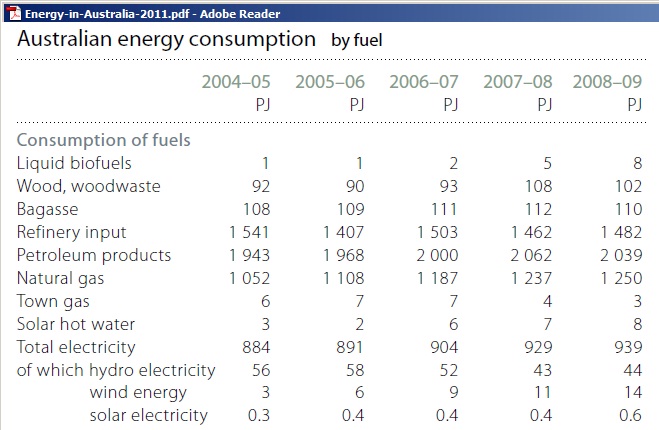 http://www.ret.gov.au/energy/Documents/facts-stats-pubs/Energy-in-Australia-2011.pdf
http://www.ret.gov.au/energy/Documents/facts-stats-pubs/Energy-in-Australia-2011.pdf
Barney Foran, formerly CSIRO, presented sustainable bio fuel solutions in his publication
Powerful choices, transition to a bio fuel economy in Australia
June 2009
http://lwa.gov.au/products/pn30178
“Replacing 90% of transport oil requirements with bio-methanol is physically feasible out to 2051and avoids an accumulated 3.3 to 4.3 billion tonnes of carbon dioxide emissions (or 15% of base case emissions) while maintaining economic productivity equivalent to the base case. The total land stock required for wood production reaches 57 million hectares by 2051 or 39 million hectares if improved transport technologies are assumed. These wood enterprises produce between 220 and 320 million tonnes per year by 2051. The energy ratios achieved by bio-methanol production vary between 6:1 and 9:1, the later level achieved when conversion plants become electricity neutral through a full recycling of process heat. By comparison, domestic oil currently has an energy ratio of around 8:1 which will decline to 5:1 when domestic stocks approach depletion.
The large area of wood planting affects cropping and intensive pasture land to a minimal degree as planting rules dictate that the ‘rough land’ category takes up most of the planting load. Large areas of trees increase the national evapotranspiration, and reduce national runoff by 3,500 to 7,000 GL per year in 2051 compared to the base case. The planting rules assume that key areas of Murray-Darling Basin are excluded from wood planting and that fine-scale catchment modelling would provide planting regimes that have minimal impact on managed water yield.”
The table above gives an idea of what task is ahead if one were to use bio fuels to replace petroleum based fuels.
Conclusion:
It is an illusion to think that E10 can in any meaningful way mitigate the impact of declining oil production and shrinking global oil exports. In the contrary, motorists may get the impression – once they have accepted E10 – that bio fuels will allow them to continue with current driving habits. What’s worse, the government’s current bio fuels strategy is used in environmental impact studies of tollways, creating the false perception that there can be a transport fuel revolution.
Links used:
Manildra http://static.lifeislocal.com.au/multimedia/images/large/1653049.jpg
Related posts:
20/1/2012 Australian Peaky Leaks goes mainstream
http://crudeoilpeak.info/australian-peaky-leaks-goes-mainstream
20/11/2011
APEC energy intensity reductions: what it means for Australian oil consumption
http://crudeoilpeak.info/apec-energy-intensity-reductions-what-it-means-for-australian-oil-consumption
